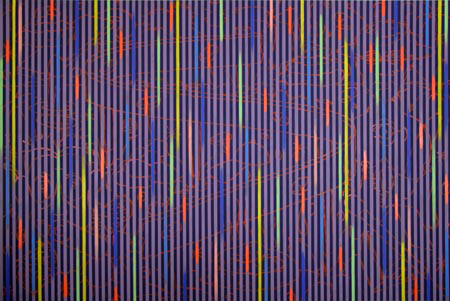
Continuing through August 28, 2011
The commonplace window coverings that we designate today as Venetian blinds trace their origins to what is now modern-day Iran. Discovered by Venetian merchants in the 18th century, and taking immediate hold in France, where they are commonly referred to by the more historically accurate name of “les Persiennes,” their undiminished popularity owes largely to innovations in 1950s aluminum manufacturing that resulted in a durable and cost-effective variant adapted to America’s Postwar onslaught of mass suburbanization.
Up-cycling this commonplace household appurtenance from the realm of domestic functionality into the sphere of contemporary artistic practice is one theme in Michael Cook’s current exhibition. “Venetian,” is comprised of twenty-four oil on canvas paintings and gouache works on paper whose figurative compositions are subsumed under obfuscating scrims of vertical lines that evoke and upturn the blinds’ fragmentation of perspective. Though unified by their equidistant vertical bands and their predominantly consistent horizontal format, Cook’s recent works examine three distinct ideas.
Catalyzed by the partially obstructed view from the Venetian blind equipped window of the New Mexico-based artist’s first Albuquerque home, these initial paintings that bear Cook’s signature banding do so in a way that navigates between landscape and abstraction. Emphasizing the degree to which technologically-mediated representations of nature inform and supersede direct observation of natural phenomena, these works co-opt satellite imagery of New Mexico sites that are home to the state’s advanced military and scientific research facilities. Here, the conventions of traditional scenic painting are challenged and the increasingly digital texture of our world is emphasized via the artifacts of computer-assisted viewing and the distorting effects of Cook’s cyber-impressionistic vertical bars. Agitating the mechanics of human optics by means of diverse lighting effects – particularly the use of contrasting color and tone to generate perceived shifts in hue, size, and brightness – the resulting images recall modes of camouflage and the protected secrecy of local forms of governmental land use.
Entitled “Venetian [Mesoscale],” the second body of paintings eschews the lowered glance of the artist’s landscapes in favor of the upwards-tilted perspectives of clouds. Informed by Turner’s expressionistic sky studies, Tintoretto’s iconic colorito, Stieglitz’s Equivalents, as well as Sherrie Levine’s digitized abstractions of the latter, this series offers trenchant analyses of the contingencies of human vision. Here, amorphous cloud forms give rise to face-in-the-clouds type pareidoliac illusions. The contrast of the bars against the un-modulated negative space of the amorphous clouds’ surrounding skies heightens the intensity of Cook’s rigorously realized chromatic dissonances.
The exhibition’s third and final series, “Venetian [ID],” builds the intensification of Cook’s interest in the optical play of his compositions. Working in a palette of dazzling neons that suggest the immediacy of Krylon spray paints, the artist transposes mock-ups of spontaneously executed automatist notations doodled on paper while watching the evening news. Hyper-sexualized and willfully retro-adolescent, the outlines of disembodied genitals, bonfires, assorted aspersions, crudely schematized houses, and lewd art historical allusions (Courbet’s “The Origin of the World” among them), simulate the visual overload and image-obsessed sensationalism of television programming.
In each series, our shared spaces of landscape, sky, and mass culture act as backdrops obscured by the visual signature of the domestic sphere. In Cook’s deftly considered work, the Venetian blind’s unremitting reminder of our inability to glimpse the world but partially, the slurred perception of the fragmented gaze, and the persistent tension between material fact and perceptual assumption sensitize us to the abstractness of being home.
